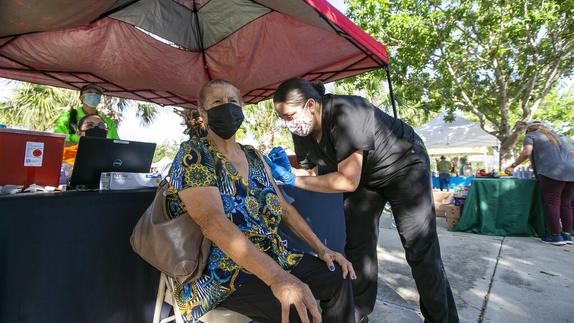 In this file photo taken on Aug 28, 2021, a volunteer administers her COVID-19 vaccine at the City of Brownsville's Department of Public Health's popup COVID-19 vaccine clinic in Brownsville, Texas. (DENISE CATHEY / THE BROWNSVILLE HERALD VIA AP)
In this file photo taken on Aug 28, 2021, a volunteer administers her COVID-19 vaccine at the City of Brownsville's Department of Public Health's popup COVID-19 vaccine clinic in Brownsville, Texas. (DENISE CATHEY / THE BROWNSVILLE HERALD VIA AP)
NEW YORK / JOHANNESBURG / ROME / LONDON / MADRID - About one-in-three COVID-19 cases in the United States are now caused by the BA2 Omicron sub-variant of the coronavirus, according to government data on Tuesday that also showed overall infections still declining from January's record highs.
In the Northeast, including New Jersey, New York and Massachusetts, Omicron BA2 now makes up more than half the cases, according to data from the US Centers for Disease Control and Prevention
Despite the rise of the extremely contagious sub-variant also seen in other countries, US health experts say a major wave of new infections here appears unlikely.
In the Northeast, including New Jersey, New York and Massachusetts, Omicron BA2 now makes up more than half the cases, according to data from the US Centers for Disease Control and Prevention.
It accounted for 35 percent of US infections for the week ending March 19, CDC said. That compares with 22.3 percent for the week ending March 12, which was revised down from 23.1 percent, according to a CDC model that estimates proportions of circulating variants.
Top US infectious disease official Dr Anthony Fauci said at a Washington Post event on Tuesday that he does not believe there will be a major surge soon, "unless something changes dramatically."
Still, Fauci noted that cases in the United States generally lag around three weeks behind the United Kingdom, "so if we are going to see an uptick, we should start seeing it within the next week or so."
The sub-variant is more transmissible than the Omicron BA1 variant that caused the massive winter surge, the World Health Organization has said. It does not appear to cause more severe disease, however, and early data showed that infection with BA1 offers strong protection against reinfection with BA2, the WHO said.
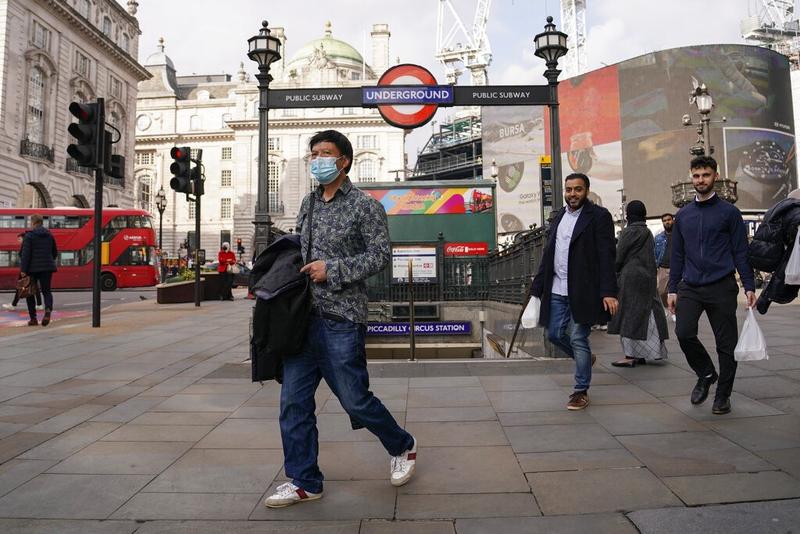 A man wears a face mask as he walks in Piccadilly Circus, in London on Oct 19, 2021. (ALBERTO PEZZALI / AP)
A man wears a face mask as he walks in Piccadilly Circus, in London on Oct 19, 2021. (ALBERTO PEZZALI / AP)
Britain
As Britain moved to lift all COVID-19 restrictive measures, vulnerable communities in Britain feel that relaxing restrictions this much will cost even more lives.
Last month, British Prime Minister Boris Johnson announced the end of all domestic COVID-19 restrictions in England. British Travel Secretary Grant Shapps recently announced all COVID-19 travel restrictions are to be removed, prompting further concern regarding transmission of the virus from overseas.
More than 91 percent of people aged 12 and above in Britain have had their first dose of vaccine, more than 85 percent have received both shots and more than 67 percent have received booster jabs.
But these measures have not been reassuring for vulnerable communities. It is estimated there is up to 3.7 million people who are classed as clinically extremely vulnerable in Britain.
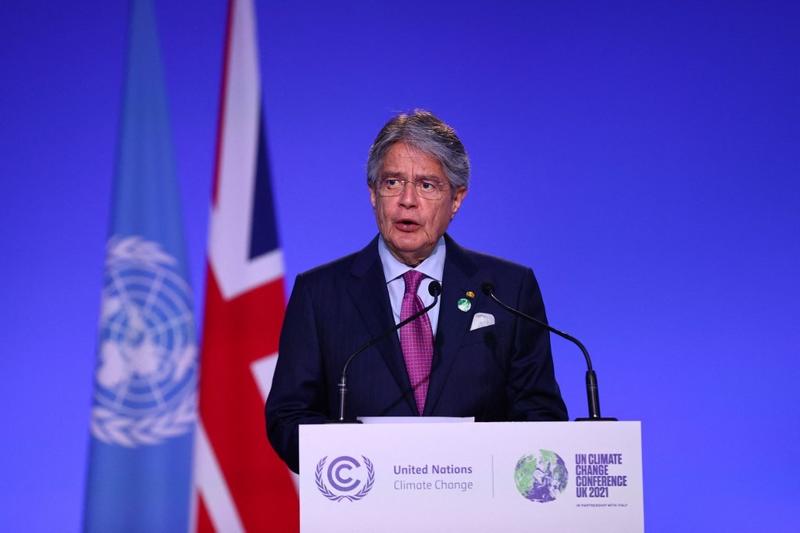 Ecuador's President Guillermo Lasso Mendoza makes a national statement on the second day of the COP26 UN Climate Summit in Glasgow on Nov 2, 2021. (ADRIAN DENNIS / POOL / AFP)
Ecuador's President Guillermo Lasso Mendoza makes a national statement on the second day of the COP26 UN Climate Summit in Glasgow on Nov 2, 2021. (ADRIAN DENNIS / POOL / AFP)
Ecuador
President Guillermo Lasso said Tuesday that as Ecuador is seeing a low level of new COVID-19 infections, people can return to normal life in May if the trend continues.
"Ecuador has reached a very low level of infections, no more than 5 percent, with one of the best indicators in the region," Lasso told media.
"We will probably wait to reconfirm all the positive trends until May, and then we will make a decision for absolute and complete normalcy," he added.
The decline in infections is attributed to the mass vaccination campaign against COVID-19, which has fully immunized 85 percent of the target population over five years old, or 16.1 million people.
In an effort to stimulate the economy, Ecuador has eliminated capacity restrictions in open and closed spaces for public events, businesses and leisure activities.
As of Monday, the South American country had reported 854,252 COVID-19 cases with 25,215 deaths, according to the Ministry of Public Health.
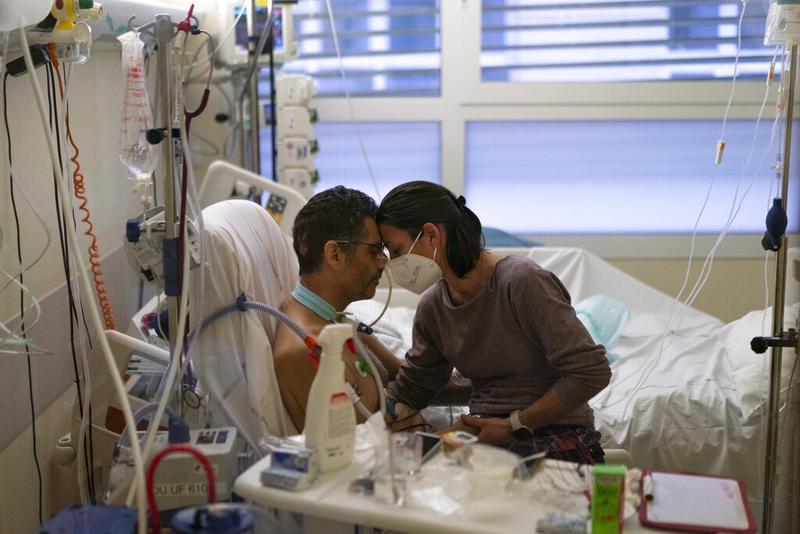 A couple holds each other at a COVID-19 intensive care unit of the la Timone hospital in Marseille, southern France on Dec 23, 2021. (DANIEL COLE / AP)
A couple holds each other at a COVID-19 intensive care unit of the la Timone hospital in Marseille, southern France on Dec 23, 2021. (DANIEL COLE / AP)
France
France saw the biggest jump in new COVID-19 cases since February, health ministry data showed on Tuesday, with 180,777 new infections over 24 hours, and hospital numbers also rose for the third consecutive day.
The new cases brought the cumulative number of registered infections to 24.3 million as the resumption of classes following two weeks of school holidays marked a sharp resurgence of the epidemic.
The seven-day moving average of new cases rose further to just under 99,000, where it had been from end-December till mid-February, driven by the contagious Omicron variant of the novel coronavirus.
The health ministry also reported that the number of people hospitalized with COVID-19 in France rose by 36 to 20,742 over the past 24 hours, and was down just 0.8 percent compared to a week ago. Week-on-week the number of patients had been falling steadily since Feb 10, but the rate of improvement has slowed down in the past few weeks.
French new infections have been increasing again since the beginning of the month but Health Minister Olivier Veran has said this trend should reverse by the end of March. Most of the country's COVID-19 restrictions were lifted a few weeks ago.
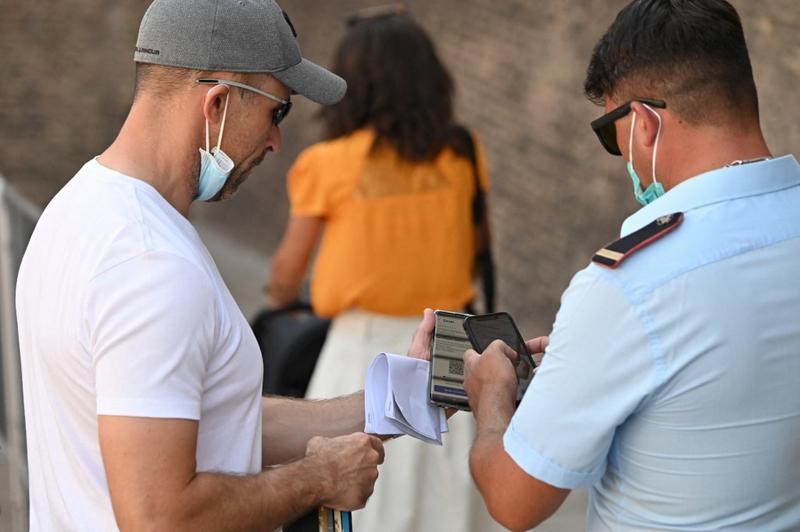 In this file photo taken on Aug 6, 2021, a
visitor shows his COVID-19 certificates for scanning before entering the Vatican Museums in the Vatican. (ANDREAS SOLARO / AFP)
In this file photo taken on Aug 6, 2021, a
visitor shows his COVID-19 certificates for scanning before entering the Vatican Museums in the Vatican. (ANDREAS SOLARO / AFP)
Italy
Improving school ventilation systems can help reduce COVID-19 cases among students, an Italian study released on Tuesday showed.
The study, conducted by the Hume Foundation, an Italian think tank, involved 10,441 classrooms in Marche in central Italy, of which 316 classrooms were equipped with mechanical ventilation systems while the other 10,125 were not.
In the 316 classrooms with mechanical ventilation systems, there were far fewer cases of COVID-19, and the number of infections reduced in step with the quality of the school's ventilation system, according to the study.
Compared to levels in classrooms with no ventilation systems, COVID-19 cases were reduced by 40 percent when classroom air was completely replaced every 25 minutes.
When the air was completely replaced every 15 minutes, cases were lower; and in cases where the air was replaced every 10 minutes, reported COVID-19 cases were much lower, the study showed.
 Customers queue to buy fireworks outside the St Mary Cathedral in Johannesburg, on December 30, 2021, ahead of New Years eve celebrations on Dec 31, 2021. (MARCO LONGARI / AFP)
Customers queue to buy fireworks outside the St Mary Cathedral in Johannesburg, on December 30, 2021, ahead of New Years eve celebrations on Dec 31, 2021. (MARCO LONGARI / AFP)
South Africa
South African President Cyril Ramaphosa announced the easing of some lockdown regulations on Tuesday night in light of decreasing COVID-19 cases in recent days.
He said the Cabinet decided to ease a few restrictions as part of adjusted alert level 1 based on consultations and recommendations from the National Coronavirus Command Council.
According to the president, gathering restrictions are significantly changed as venues are allowed to accommodate up to 50 percent of their capacity, as long as proof of vaccination is shown or an updated COVID-19 test is conducted within 72 hours.
This change in the restrictions on gatherings will be of great benefit to the sports, culture and entertainment industries in particular.
"The maximum number of people permitted at a funeral will increase from 100 to 200. As before, night vigils, after-funeral gatherings, and 'after-tears' gatherings are not allowed," Ramaphosa said.
He added that people still need to wear masks when in shops, malls, offices, factories, taxes, buses, trains or any other indoor public space.
International travelers will be required to show proof of vaccination or a negative PCR test within 72 hours before entering South Africa.
"We intend to lift the National State of Disaster as soon as a public comment on the health regulations published by the minister of health has been completed," he said.
Health regulations intended to replace the National State of Disaster have been released for public comment. The public can comment on the proposed health regulations until April 16.
"These regulations, when finalized, will replace the State of Disaster as the legal instrument that we would use to manage the pandemic," he said, "The end of the National State of Disaster will not mean the end of the pandemic. It just means that we are changing the way we are managing the pandemic."
The president said some 60 percent to 80 percent of the population has some form of immunity to the virus, either from previous infection or vaccination, and the most important defence against the disease is vaccination.
In South Africa, there have been more than 3.7 million cases of COVID-19 and nearly 100,000 deaths related to the pandemic over the last two years.
Spain
Spain announced on Tuesday that people with COVID-19 will no longer have to remain in quarantine for seven days if they are asymptomatic, or only have mild symptoms.
The decision was reached at a meeting of the country's Public Health Commission, attended by the Health Ministry and representatives of the country's 17 Autonomous Communities. It will come into effect on March 28.
As of that date, diagnostic tests will also cease to be obligatory for all possible COVID-19 cases. They will only be required for vulnerable people (those over 60 years old, pregnant women or those with immune deficiency issues), or those working in vulnerable environments such as health and social care.
For cases presenting only light symptoms, the Health Ministry recommends continued use of face masks and social distancing.
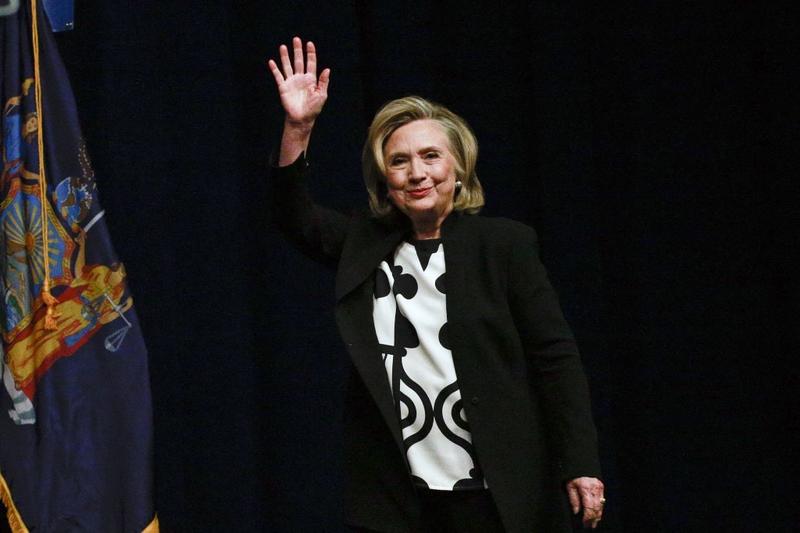 In this file photo taken on Feb17, 2022 Former US secretary of state and former senator Hillary Clinton arrives for the New York Democratic Party 2022 state Nominating Convention in New York City. (KENA BETANCUR / AFP)
In this file photo taken on Feb17, 2022 Former US secretary of state and former senator Hillary Clinton arrives for the New York Democratic Party 2022 state Nominating Convention in New York City. (KENA BETANCUR / AFP)
US
Former US secretary of state Hillary Clinton announced on Tuesday evening that she had contracted COVID-19 with mild symptoms.
"I've got some mild cold symptoms but am feeling fine," tweeted the 74-year-old, who was also the 2016 Democratic presidential nominee, adding that she had been vaccinated.
"I'm more grateful than ever for the protection vaccines can provide against serious illness," she said.
Her husband, former US president Bill Clinton, tested negative on Tuesday for the coronavirus and is "feeling fine," according to a follow-up tweet.
Bill Clinton, 75, is "quarantining until our household is fully in the clear," Hillary Clinton wrote.
The tweets came only hours after White House press secretary Jen Psaki announced a positive test result, the second for her in just a few months.
"Thanks to the vaccine, I have only experienced mild symptoms," Psaki said in a statement, adding US President Joe Biden tested negative on Tuesday via a PCR test.
Hillary Clinton and Psaki are the latest in a series of prominent US figures who have recently been infected with COVID-19, joining a list that also includes former US president Barack Obama and second gentleman Doug Emhoff, husband of US Vice-President Kamala Harris.
Meanwhile, children aged 0-4 in the latest Omicron wave in the United States were hospitalized at approximately five times the rate of the Delta wave, according to a recent study by the US Centers for Disease Control and Prevention.
From Dec 19, 2021 to Feb 19, 2022 when the Omicron variant predominated, weekly COVID-19-associated hospitalization rates per 100,000 children aged 0-4, a group not yet eligible for vaccination, peaked at 14.5, which was approximately five times that during the Delta-predominated period from June to December in 2021, said the study based on data from 14 states.


